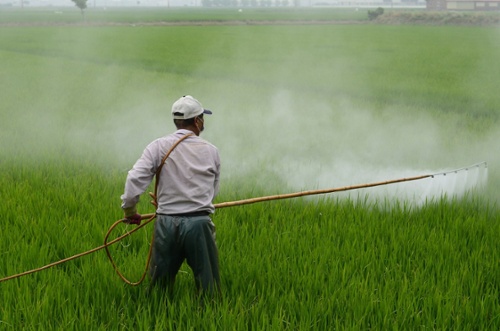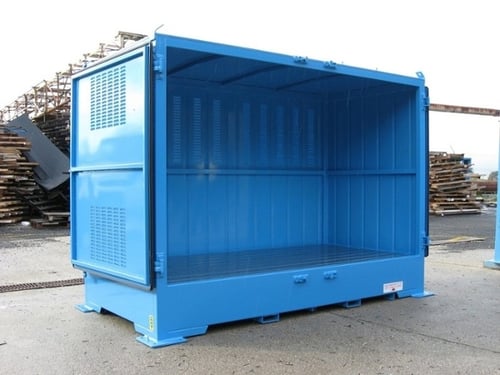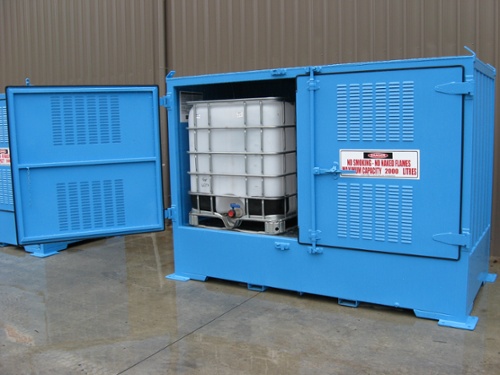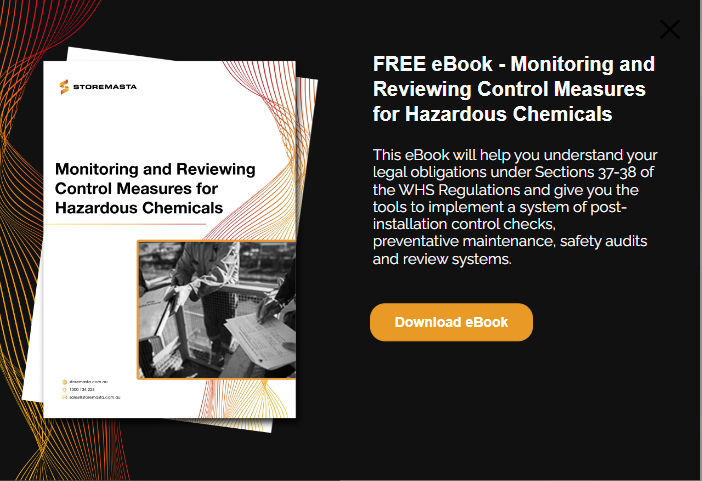If you’re working with any type of pesticide or agricultural chemical, this blog will help you meet your compliance obligations. In Part 2 of our short blog series, we’ll be focusing on the considerations you will need to make when you’re selecting indoor or outdoor storage for your farm chemicals. We’ll be listing key design, construction and additional storage requirements for ag enterprises that are keeping farm chemicals in quantities that exceed minor storage.
Storing Ag Chemicals
Just like any type of dangerous goods, if pesticides and agricultural chemicals aren’t stored in a compliant way they can pose a range of risks to human health, animal life, the environment — and even the broader community. Incidents such as toxic chemical spills or the ignition of flammable vapours can occur if your storage areas aren’t designed, constructed and managed in a safe way.
In Section 3 of the Australian Standard AS 2507:1998 – The storage and handling of agricultural and veterinary chemicals, you’ll find detailed requirements for chemical stores and storage areas.
The types of storage area that you can create to house your pesticides and ag chemicals may be one or more of the following:
Indoors
- a building attached to your building
- room, enclosure or area within your building
Outdoors
- free-standing roofed building
- outdoor storage area with security fence
IMPORTANT: Agricultural chemicals should generally be stored under cover, as this provides protection for your packages. If you’re storing your chemicals in uncovered storage, check the Safety Data Sheet (SDS) of your products to ensure that your substances are stable under those conditions. Uncovered chemical storage should only be used a short-term solution.
If a custom-built storage area is not a feasible option for your enterprise, choosing a compliant safety cabinet or pesticide cabinet is suitable for indoor use — while an outdoor chemical storage container is a compliant option for outdoor locations.
An outdoor chemical storage container made for the dangerous goods class of the chemical that you’re keeping is a compliant storage option.
Construction Requirements
The construction requirements that apply to storage areas for farm chemicals include the following provisions:
- Floors must be impervious and resistant to chemical attack
- Floors must be designed and constructed so that molten chemicals, in the event of a fire, are diverted into a suitable area for disposal
- Construction materials shall be non-combustible (refer to AS 1530.1.)
- Spills and leaks must be directed into a drainage system, away from other storage areas, buildings or combustible materials, to a place where chemicals can be readily collected. NOTE: EPA requirements also apply
- Building components up to the maximum bund height must be: 1. Resistant to attack from stored chemicals; 2. Have non-absorbent surfaces
Outdoor Storage
Additional requirements do apply to the outdoor storage of agricultural chemicals and pesticides. This is to further protect businesses and their communities from the risks associated with the chemicals and the possibility of unauthorised entry.
The following requirements apply to outdoor storage areas:
- If your storage area is located within an adequately secured premises, you may not require additional fencing. However, your outdoor storage area must be secured by a compliant fence (AS 1725) or equivalent – with two strands of barbed wire on top
- When a gate is required, it must be lockable. It should open outwards from the storage area
- Your agricultural chemical outdoor storage area must not be located along the emergency escape route
REMEMBER: When storing agricultural chemicals in an outdoor chemical storage container, they are secured from unathorised entry with ISO locking bars. This provides secure storage for the hazardous chemicals and reduces the risk of theft, vandalism and general chemical misuse.
Further Considerations For Chemical Storage
When storing your agricultural chemicals, there are many important factors that must be considered to create a safe and compliant environment for storage. We’ll look at these planning and design considerations in more detail below.
Consider Chemical Type and Quantity
You should ensure that your storage is suitable for the type and quantity of hazardous chemical. For example, if your insecticides are Class 6.1 Toxic Substances, then they should be housed in a chemical cabinet or outdoor chemical store that’s been manufactured to meet the requirements of AS/NZS 4452:1997 – The storage and handling of toxic substances. If your farm chemicals are regarded as Class 3 Flammable Liquids, your cabinet or store should be constructed in full conformance with AS 1940:2017 – The storage and handling of flammable and combustible liquids. Each class of dangerous goods poses its own set of risks, so the storage that you choose should be compatible with the stored chemical product.
REMEMBER: You should never store anything else but the relevant dangerous goods class in your dedicated indoor safety cabinet or outdoor chemical store. Never mix different classes of dangerous goods in the same agricultural chemical storage facility.
In addition to this, you must also ensure that you never load a chemical cabinet or store past its maximum capacity rating. Doing so will negate the risk control measures of the storage equipment and increase the likelihood of hazardous vapour emissions, chemical spills and damage to packages.
Toxic pesticides should be kept in a compliant chemical storage container to reduce risk in your ag operations.
Storage of Flammable and Combustible Substances
If your pesticides or agricultural chemicals are Class 3 substances, they must be stored to meet the requirements of AS 1940:2017. In addition to meeting the requirements of this standard, you must also make sure that:
- An assessment of hazardous areas is conducted, and ignition sources are dealt with accordingly
- Any roofs over driveways and loading areas, which may impede firefighting efforts or increase the risk of fire, must also be subject to assessment
Chemical Segregation
Incompatible chemicals should never be stored in the same area — unless you apply the rules of chemical segregation. While dedicated pesticide cabinets and outdoor stores provide chemical segregation for the stored goods, you must ensure that incompatible substances aren’t handled or stored near each other as a reaction could occur.
Most agricultural chemicals will be incompatible with other chemical classes — and therefore, must be separated. For example, many of the pesticides that you’ll find on your farm will be classed as toxic substances. Toxic substances are incompatible with most classes of dangerous goods including flammable gas, flammable liquids, flammable solids, spontaneously combustible, oxidising agents and organic peroxides. Therefore, they must be separated from incompatible substances by a distance of at least 3 metres.
If you’re storing multiple classes of dangerous goods, make sure you follow the segregation requirements to maintain chemical safety and compliance.

Check the SDS of your pesticides and ag chemicals to determine the type of dangerous goods storage that you will require.
Ventilation Requirements
Storage areas must be adequately ventilated so that the level of hazardous vapours generated within the storage area remains within workplace exposure standards and explosive limits.
Natural ventilation systems may be at least two walls of louvres that allow for the dispersion of hazardous vapours into the surrounding environment. If a mechanical ventilation system is required for indoor storage, then it must comply with the regulations and meet requirements including the capability of exhausting 0.3 m3 per square metre of floor area per minute of 5 m3 per minute, whichever is greater.
Spillage Containment
As with all hazardous chemicals, if there is a risk that a chemical spill could occur, there must be adequate spillage containment provided.
For pesticides and agricultural chemicals, all liquid or solid chemical spills must be contained in a compliant spill containment system, along with any resulting effluent. Spill containment may include options such as a bunded area, a sloping floor or trenches.
Chemicals and any run-off must be contained to prevent hazards such as fire, excessive hazardous vapour emissions, environmental damage and water pollution.
IMPORTANT: Compliant safety cabinets or chemical storage containers, such as an outdoor flammable store, are constructed with compliant spill containment systems that meet the requirements of the Australian Standards.
Spillage containment compounds must meet the capacity requirements:
- For package stores, the compound capacity must be at least 100% of the largest package, plus 25% of the storage capacity up to 10 000 L, together with 10% of the capacity over 10 000 L.
- For IBC storage areas, the compound capacity must be at least 25% of the total capacity of the IBCs and 100% of the capacity of the largest IBC.
- If both chemical packages and IBCs are kept in the storage container or area, the spill containment capacity must meet the total containment capacities as specified above.
Keeping Agricultural Chemical Stores Compliant
While we’ve touched on the key requirements for the storage of agricultural chemicals (in quantities that exceed those of minor storage), this is just a brief overview of the safety considerations you should make when storing your pesticides and farm chemicals. In our next blog, we’ll be detailing how you can use and maintain your ag chemical stores in the right way.
If you’re interested in learning more about chemical safety, we have an easy-to-read eBook that can help. Monitoring And Reviewing Control Measures For Hazardous Chemicals will help you take a risk management approach to hazard controls and help you maintain and review your chemical controls. This guide can be easily applied to any workplace that uses any type or quantity of hazardous chemicals. – including farms and agricultural enterprises. Grab your copy for free today.
Like what you’re reading? Explore our short blog series
Part 1 Pesticide and Agricultural Chemical Requirements (Part 1): Minor Storage
Joining the team as a Dangerous Goods Storage Consultant, Melissa Hampton became Storemasta's Marketing Manager in late 2021. With extensive knowledge and experience in chemical compliance, Melissa is responsible for leading the Marketing team and helping shape their marketing strategy. In her spare time, you can find Melissa hiking, swimming and enjoying the great outdoors in beautiful north-west Tasmania.



